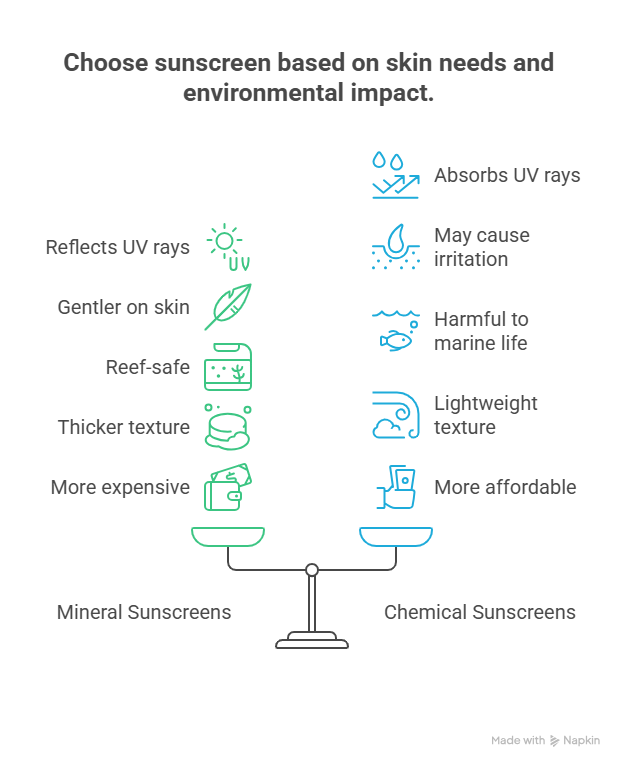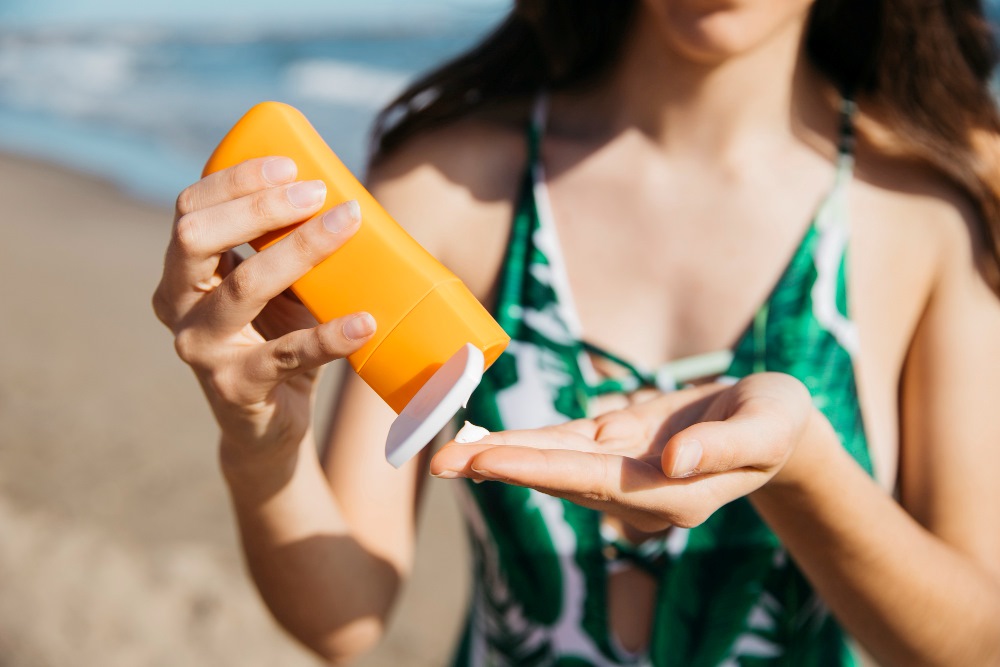If you have sensitive skin, sunscreen can feel like a gamble. Some protect well but sting. Others feel gentle but clog pores or leave rashes behind. That’s why choosing the right kind matters more than just picking the highest SPF.
There are two main types—mineral and chemical. Both shield your skin from harmful UV rays, but they work in different ways and have different effects on sensitive skin.
This guide breaks down how each type works, what to watch out for, and which one is likely a better fit if your skin reacts easily. Let’s start with the basics.
Table of Contents
What Are Sunscreens and Why They Matter for Sensitive Skin
Sunscreens are products that help block or absorb the sun’s ultraviolet (UV) rays to protect your skin. UV rays can cause sunburn, dark spots, wrinkles, and even skin cancer. For sensitive skin, though, the risk goes beyond sun damage—many sunscreens can trigger redness, stinging, or breakouts.
Sensitive skin reacts faster to certain ingredients, especially fragrances, alcohol, and preservatives, often found in chemical sunscreens. Even short sun exposure can lead to irritation or flare-ups if your skin barrier is already weak or inflamed.
Using the right sunscreen helps prevent more than just sunburn. It keeps your skin calm, shields it from long-term damage, and avoids extra stress from harsh formulas. But not all sunscreens are created equal.
Next, we’ll break down how mineral and chemical sunscreens are, how they work and whether they are safer for sensitive skin or not.
Understanding Mineral Sunscreens
Mineral sunscreens, also called physical sunscreens, use natural minerals like zinc oxide or titanium dioxide as active ingredients. These formulas sit on the surface of your skin instead of absorbing into it. Because of this, they’re often less irritating and are commonly recommended for people with sensitive or reactive skin.
How They Work
Mineral sunscreens protect your skin by forming a barrier that reflects UV rays away. Unlike chemical sunscreens, they don’t absorb into your skin. Instead, they act like a shield, bouncing sunlight off before it can penetrate. This protection starts immediately after application, which makes it easier for people with sensitive skin to avoid reactions.
Pros of Mineral Sunscreens
- Gentle on skin; less likely to cause irritation or allergic reactions.
- Offer broad-spectrum protection (UVA and UVB).
- Often safe for babies, acne-prone skin, eczema, and rosacea.
- Reef-safe and less harmful to marine life.
Cons of Mineral Sunscreens
- Can leave a white cast, especially on deeper skin tones.
- Thicker consistency; may feel heavier on the skin.
- May require more frequent reapplication, especially after sweating or swimming.
Understanding Chemical Sunscreens
Chemical sunscreens use synthetic compounds like avobenzone, oxybenzone, octinoxate, or octocrylene to protect your skin. These ingredients absorb into the top layer of your skin and work from within. They’re widely available, often more cosmetically elegant, and usually come in lighter, easier-to-blend formulas.
How They Work
Chemical sunscreens absorb UV rays and convert them into heat, which is then released from the skin. This process happens below the surface, which is why chemical sunscreens need time—usually 15 to 30 minutes—to become effective after application. Because they work from within, they may be more likely to cause irritation for people with sensitive or reactive skin.
Pros of Chemical Sunscreens
- Lightweight and easy to spread; often preferred under makeup.
- No white cast, making them a better fit for darker skin tones.
- Water- and sweat-resistant options are more widely available.
- Often less noticeable on the skin after application.
Cons of Chemical Sunscreens
- Higher risk of irritation or allergic reactions, especially for sensitive skin.
- Some ingredients like oxybenzone may disrupt hormones or cause skin sensitivity.
- Can sting if applied near the eyes.
- Environmental concerns—some ingredients are harmful to coral reefs.
Key Differences at a Glance
| Feature | Mineral Sunscreens | Chemical Sunscreens |
| Ingredients | Zinc oxide, titanium dioxide | Avobenzone, oxybenzone, octinoxate, octocrylene |
| UV Protection Method | Reflects UV rays at the surface | Absorbs UV rays and converts them into heat |
| Skin Compatibility | Gentler on sensitive skin; less likely to irritate | May cause stinging or breakouts in sensitive skin |
| Environmental Impact | Generally reef-safe and ocean-friendly | Some ingredients may harm marine life and coral reefs |
| Texture and Finish | Thicker; may leave white cast on darker skin tones | Lightweight; blends easily with no residue |
| cost | Often slightly more expensive | Usually more affordable and widely available |
Both mineral and chemical sunscreens offer UV protection, but they work differently and feel different on the skin. Mineral formulas tend to be safer for sensitive skin and the environment, but may feel heavier. Chemical options blend better and often cost less, but can trigger irritation in reactive skin. Choosing the right one depends on your skin’s needs, comfort, and daily routine.

Best Sunscreen Choice for Sensitive Skin
Most dermatologists recommend mineral sunscreens for sensitive skin, especially those made with zinc oxide. Zinc is less likely to cause breakouts, redness, or burning. It’s also a common go-to for people with eczema, acne, or rosacea.
When reading labels, look for products that are “fragrance-free”, “non-comedogenic”, and “hypoallergenic.” These terms suggest the formula is less likely to clog pores or trigger irritation. A short ingredient list is often a good sign too.
Red Flags in Sunscreen Labels
Avoid sunscreens with the following if your skin reacts easily:
- Fragrance – often causes irritation or allergic reactions
- Alcohol (especially denatured) – can dry and sting
- Essential oils – natural but harsh for reactive skin
- Preservatives like parabens or formaldehyde-releasers
- Unclear or vague labeling – skip products that don’t list full ingredients
- Aggressive marketing claims like “waterproof” or “sweatproof” without explaining how
Patch Testing: A Simple but Crucial Step
Before using any new sunscreen on your face or body, do a quick patch test. Apply a small amount to your inner arm or behind your ear and wait 24 hours. If there’s no redness, itching, or rash, it’s likely safe to use more broadly.
Testing first helps avoid full-face flare-ups—something anyone with sensitive skin wants to prevent.
Conclusion: So, Which Is Better for Sensitive Skin?
If you have sensitive skin, mineral sunscreens are a better choice for most people. They’re less likely to irritate, work right away, and contain simple, skin-friendly ingredients like zinc oxide. That makes them safer and more reliable for daily use on reactive skin.
Chemical sunscreens might feel lighter and blend better, but they come with a higher risk of stinging, breakouts, or allergic reactions, especially if your skin is already sensitive or inflamed.
The decision is simple:
- Choose mineral sunscreens if your skin often reacts or you’re unsure what triggers irritation.
- Only consider chemical sunscreens if you’ve patch-tested and know your skin can handle them.
When in doubt, go mineral. Your skin will thank you.



